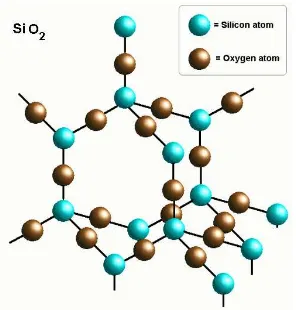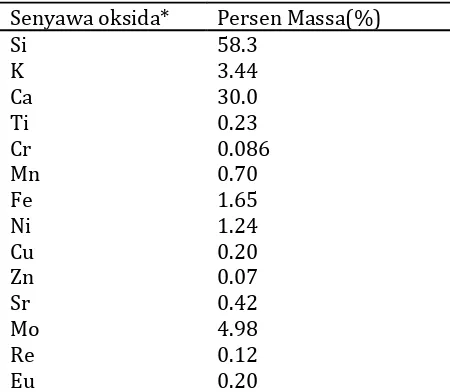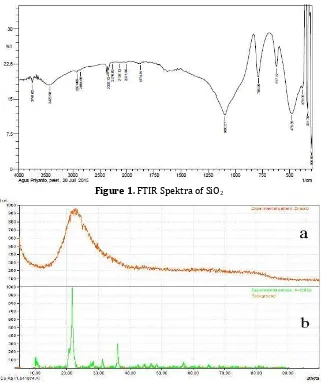Copyright @2017, JNSMR, ISSN: 2460-4453
Available online at http://journal.walisongo.ac.id/index.php/jnsmr
Synthesis and Structure Characterization of SiO
2from Petung Bamboo
Leaf Ash (Dendrocalamus asper (Schult.f.) Backer ex Heyne)
Wirda Udaibah1 and Agus Priyanto1
1Chemistry Education Departement, Faculty of Sains and Technology, Universitas Islam Negeri Walisongo
Central Java,Indonesia
Corresponding author: wirda_udaibah@walisongo .ac.id
Recived: 30 April 2017, Revised : 04 June 2017 Accepted: 25 June 2017.
Abstracts
The Research about Synthesis and Characterization of SiO2 have been worked. We
have synthesized Silica from petung bamboo leaf ash as SiO2 source. This step
used sol gel methode. SiO2 were characterized by Fourier Transform Infra Red
(FTIR) to investigated the stucture andX-Ray Diffaction to know about structure and crystallinity. FTIR spectra show peak at 617,22 cm-1 area that spesific for
Si-H bond, peak at 786,96 cm-1and 1095,57 cm-1 area specific for Si-O-Si bonds.
Difractogram of SiO2 show that there are peak at θ , ; , and 38,88 were
specific for SiO2 that calcinated at 800oC, while for SiO2 that calcinated at 400oC
there were no peak at θ , dan , . That peaks not shown may be because low crystallinity of SiO2 that calcinated at 400oC. Calcination temperature greatly
affects the crystallinity of SiO2.©2017 JNSMR UIN Walisongo. All rights reserved.
Key words: Silica;Bamboo Ash Leaves; Structure Characterization.
1.
Introduction
Silica is a chemical compound with
the general formula SiO2. These
compounds can be found in nature as minerals such as sand, quartz, glass, and so on. In addition, silica can also be synthesized in the laboratory. Silica is widely used for various purposes ranging from electronics, mechanics, medical, art to other fields. Silica in nature is crystalline while artificial silica is generally amorphous. In this research, we
interested in using SiO2 material. This is
because the solid can be synthesized by utilizing local natural resources in Indonesia. SiO2 sources can be derived
from minerals such as zeolites, bentonites,
clinoptioites that are numerous in
Indonesia. In addition, SiO2 can also be
obtained from biomass such as rice husk ash, rice straw ash, and bamboo leaf ash. So far, rice husk ash has been widely studied to obtain SiO2 while bamboo leaf
ash has not been widely studied while the
Copyright @2017, JNSMR, ISSN: 2460-4453
Bamboo leaves that fall to the ground are only considered as mere waste by our community.
Figure 1. Tetrahedral structure of SiO2
It is very regrettable, because in the bamboo leaf there is still a compound that can be used that is silica. According to research by Lembaga Ilmu Pengetahuan Indonesia (LIPI), the silica content of bamboo petung species deliberately cultivated. The world's bamboo population is estimated to be 1200-1300 paper making, building, handicraft, and even medicine. However, the utilization of other parts of bamboo plants, such as roots, branches and leaves is still not maximized.
Bamboo petung is known by its
scientific name (Dendrocalamus asper
(Schult. F.) Backer ex Heyne). Bamboo
leaf [4][5]. Furthermore, research
conducted by Olugbenga O. Amu et al In 2010. The purpose of the research is to know the characteristics of bamboo ash and its influence in stabilizing to the soil of the literit on the road construction. The study provides information on bamboo leaf ash has a good potential to stabilize
The leaves of bamboo petung cleaned and dried under the sun for 2 days. The dried bamboo leaves are furthermore ignored using furnaces at a temperature of 800oC to obtain
gray bamboo petung ash. Chemical
Copyright @2017, JNSMR, ISSN: 2460-4453
with sol gel method. This method is adapted from [7]. The leaves of bamboo petung leaves are dissolved in 4 M NaOH in stop erlenmeyer. The mixture is stirred while heated at a temperature of 109 ° C. The residue is burned at a temperature of 500oC to whitish brown.
The resulting substance was then dissolved in mineralized water into a yellowish brown of sodium silicate solution. The Na silicate solution is used as a precursor of silica. The solution of silicic acid is added HCl 1 M dropwise until it has pH 7. The solution is then allowed to stand for 72 hours until gel is formed. The formed gel is then washed with demineralized water and the residue is dried in an oven at 80° C. The formed silica is then crushed and sieved with 100 mesh sieve. Silica has been heated at 400oC and 800oC for 4
hours. To test whether the catalyst has been formed, the structural structure with Fourier Transform Infra Red (FTIR) and X-ray diffraction (X-Ray Diffaction) have been isvertigated.
3.
Result and Discussion
Synthesis Silica from Petung Bamboo Leaf Ash Silica is synthesized by exploiting local potency in the form of bamboo petung leaves. then through the drying stage in the sun for 2 days. The drying rate will decrease along with the decreasing of moisture content during evaporation and the drying process does not occur at once. So in sun-drying, the heat dissipation into the material takes place gradually and thoroughly so that the evaporation of water into the air is more evenly although it takes longer time to use oven oven. When the material starts to heat from the oven, the rate of drying takes place rapidly, so that when the drying rate begins to
decrease, the remaining water content of the
temperature will produce good quality silica [9]. The higher the temperature of the probe, causing higher purity. Ash ash petung leaves were analyzed with XRF to determine their chemical composition. The results are presented in Table 1. The
reactions that occurred during the
observation were: support preparation. However, the black ash must be removed from its impurities forming a pure white SiO2. Silica from petung bamboo
Copyright @2017, JNSMR, ISSN: 2460-4453
drying and calcination [11]. The sol-gel method is relatively easy to perform, does not require a long time and the interaction between solids and immobilized materials is relatively easy.
The process of making silica is done by making precursornya first, sodium silicate. A total of 20 grams of petung bamboo ash leaves were dissolved in 160 mL NaOH 4M in stop erlenmeyer. The process aims to dissolve the base or basic destruction. The mixture was stirred while heated at 105 ° C for 90 minutes. The residue was burned at a temperature of 500oC for 30 minutes to accelerate the process of changing the leaves of bamboo petals into sodium silicate (Na2SiO3). The solid is brown
whitish. The obtained solids were dissolved in 200 mL demineralized water and allowed to stand for 3 nights to form a sodium silicate solution. The formed solution is then filtered using Whatmann 42 filter paper aims to separate the insoluble brown precipitate. The resulting sodium silicate solution is brownish yellow. The reactions that occur during this process are:
SiO2(s) + 2 NaOH(aq)→ Na2SiO3(aq) + H2O(aq)
High temperatures cause the NaOH to melt and dissociate completely into sodium ions and hydroxide ions. In SiO2, the high
electronegativity of the O atom causes Si to be more electropositive and form an unstable [SiO2OH] intermediate, then dehydrogenation
and the second hydroxyl ion binds to hydrogen to form water molecules. Two Na ions will balance the negative charge formed and interact with the SiO32- ions thus forming
sodium silicate (Na2SiO3). The sodium silicate
solution is then added HCl 1 M dropwise while stirring using a magnetic stirrer to have a pH of 7. The addition of 1 M HCl to sodium silicate solution by stirring technique can increase the resulting silica content [12]. The addition of HCl to pH 7 in sodium silicate solution occurs H2SiO3 formation, followed by the reaction of
the formation of Si(OH)4 acid sol. The reaction
can be described as follows:
through a condensation process,
according to the following reaction
Equation:
The formed gel is then allowed to stand for 72 hours. The formed gel was washed with demineralized water and the residue was dried in an oven at 80 ° C for 3 hours. The silica powder formed was then crushed and sieved with a 100 mesh sieve. The silica powder was then calcined using furnace at 400oC and also
800 ° C for 4 hours.
Characterization of Silica from Petung Bamboo Ash Leaves
The formed SiO2 is then characterized to
see which SiO2 is made as desired. The SiO2
sample is characterized by FTIR to see the bonds that occur in the sample. SiO2 spectra is
shown in Figure 1. In the spectra there is a peak in the region of 617.22 cm-1 is a Si-H
bond, peak at 786.96 cm-1 and 1095.57 cm-1 is
Si-O-Si bond. The peak at 3425.56 cm-1 shows
the Si-O-H bond. This result proves that the synthesized SiO2 is suitable. Furthermore,
characterization of the structure using XRD to know the structure and crystallinity. This characterization is performed on calcined SIO2
at two different temperatures ie 400oC and
800oC.
The synthesized SiO2 diffractogram is shown in
Figure 2 and 3. In Figure 2 (a) shows a calcined SiO2 difractogram at a temperature of 400° C.
The diffractogram is similar to the standard SiO2 listed in the Joint Committee for Powder
Copyright @2017, JNSMR, ISSN: 2460-4453
Figure 1. FTIR Spektra of SiO2
Figure 2. (a) SiO2 difractogram calcinated at 400oC (b) SiO2 standard from JCPDS
Copyright @2017, JNSMR, ISSN: 2460-4453
According to JCPDS SiO2 the specific peak
standard for SiO lies at θ . ; , and
38,88. Diffractogram obtained showed
widening peaks of several specific peaks of SiO2 so that some peaks did not appear ie
peaks at θ . and . . This result shows
the synthesized SiO2 has very low crystallinity
and degree of order [13].
Different things happen to the calcined SiO2 of the synthesized at a temperature of 800
° C. The SiO2 peak is very sharp and the specific influenced by the temperature of calcination in the synthesis process. Based on the structure characterization by FTIR and XRD it provides evidence that the synthesized silica by sol gel method succeeded in producing SiO2.
4.
Conclusion
In conclusion, solid cilica (SiO2) can be
synthesized from daum bamboo ash by sol gel method. Characterization of SiO2 structure
with XRD seen peak at θ . ; , and
38,88 shows strong character of Silica. In other hand, characterization with FTIR appears peak at 617,22 cm-1 area is Si-H bond, peak at
786,96 cm-1 and 1095,57 cm-1 is Si- O-Si..
Acknowledgement
Acknowledgments are submitted to the LP2M UIN Walisongo who has provided financial support in this research on Collaborative Research Lecturers and 2014
References
[1] Widya Fatriasari and Euis Hermiati. Analisis Morfologi Serat dan Sifat Fisis Kimia Beberapa Jenis Bambu sebagai Bahan Baku Pulp dan Kertas, UPT Balai
Penelitian dan Pengembangan
Biomaterial-LIPI, 2006.
[2] E. Widjaja, Identifikasi Jenis-Jenis Bambu di Jawa, Puslitbang Biologi-LIPI , 2001 [3] W., Liese, Preservation of Bamboo In
Jurnal Teknik Kimia, 15 (1), 2008.
[10] U. Schubert and N. Hüsing, Synthesis of Inorganics Materials, Second Edition, Wiley, VHC, Verlag Gm6H &Co, Weinheim. 2005.
[11] R. D. Gonzalez, T. Lopez, and R. Gomez, Catalysis Today, 35, pp.293, 1997.
[12] I. Pratomo, S. Wardhani, D. Purwonegoro, Kimia Student Journal, 2 (1), 2013.
[13] U. Kalapathy, Bioresource Technology, 7, 2000.
[14] C.Latif, Triwikantoro, Munasir, Sains Dan Seni Pom ITS, 3 (1), 2014.


